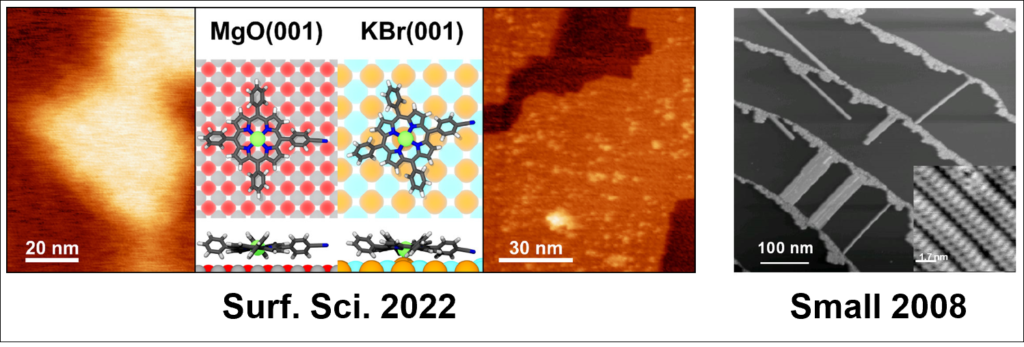Molecular structures on non-metallic substrates
Engineering electronic devices based on molecular self-assembly is a promising approach to compete with the urge to reduce their size and increase their performance. Bulk insulating substrates provide the required electronic decoupling to preserve the molecule’s functionality because the large band gap prohibits a hybridization between molecular orbitals and substrate surface states. Thus in devices, leakage currents towards the substrate in the same order of magnitude as intermolecular currents are avoided. As a result of the decoupling, the molecule-surface interactions are decreased, which demands, on the one hand, for controlled growth procedures to avoid the formation of amorphous layers. On the other hand, these intrinsic differences to metal substrates generally provide a larger structural variety in surface-supported molecular architectonics, which includes molecular adsorption in edge-on and face-on geometry compared to the mainly planar molecular networks in a face-on geometry observed on metals at submonolayer coverage. Notably, the edge-on geometry structures exhibit extraordinary electronic properties, as the efficient overlap of the molecular orbitals via π-π- stacking enables charge transport in self-assemblies of planar extended polycyclic aromatic hydrocarbons, giving rise to nanowire characteristics. We note that the control of steering the adsorption geometry from a face-on to an edge-on orientation of the molecular cores is of outermost importance for the design of molecular devices and significantly impacts their efficiency. While in a FET device, the molecules preferably align perpendicular to the electrodes, which requires an edge-on orientation, a face-on orientation is desired in photovoltaic devices such as solar cells.
We use specially designed molecular building blocks to unravel the structure formation of molecular architecture on bulk insulators and semiconducting 2D materials by tuning the molecule-molecule vs. molecule-surface interactions. Using non-contact atomic force microscopy (nc-AFM), we can study the structure of self-assembled organic molecules on insulators at the atomic scale. As model systems, we investigate alkali halide and oxide surfaces. Recently, we have focused on functional molecular structures on oxide surfaces in the framework of the DFG research group FUNCOS.

Selected publications:
- Adsorption and self-assembly of a mono-cyano Zn-tetraphenylporphyrin derivative on KBr(001) and MgO(001)
M. Ammon, M. Devarajulu, Y. Liu, M. Gurrath, D. Lungerich, N. Jux, B. Meyer, S. Maier
Surf. Sci. 723 122097 (2022) - Molecular assemblies on surfaces: towards physical and electronic decoupling of organic molecules
S. Maier, M. Stöhr
Beilstein J. Nanotechnol. 12, 950–956 (2021) - Nano-Engineering of Molecular Porphyrin Wires on Insulating Surfaces
S. Maier, L.-A. Fendt, L. Zimmerli, T. Glatzel, O. Pfeiffer, F. Diederich, E. Meyer
SMALL Vol. 4 Issue 8, 1115-1118 (2008)